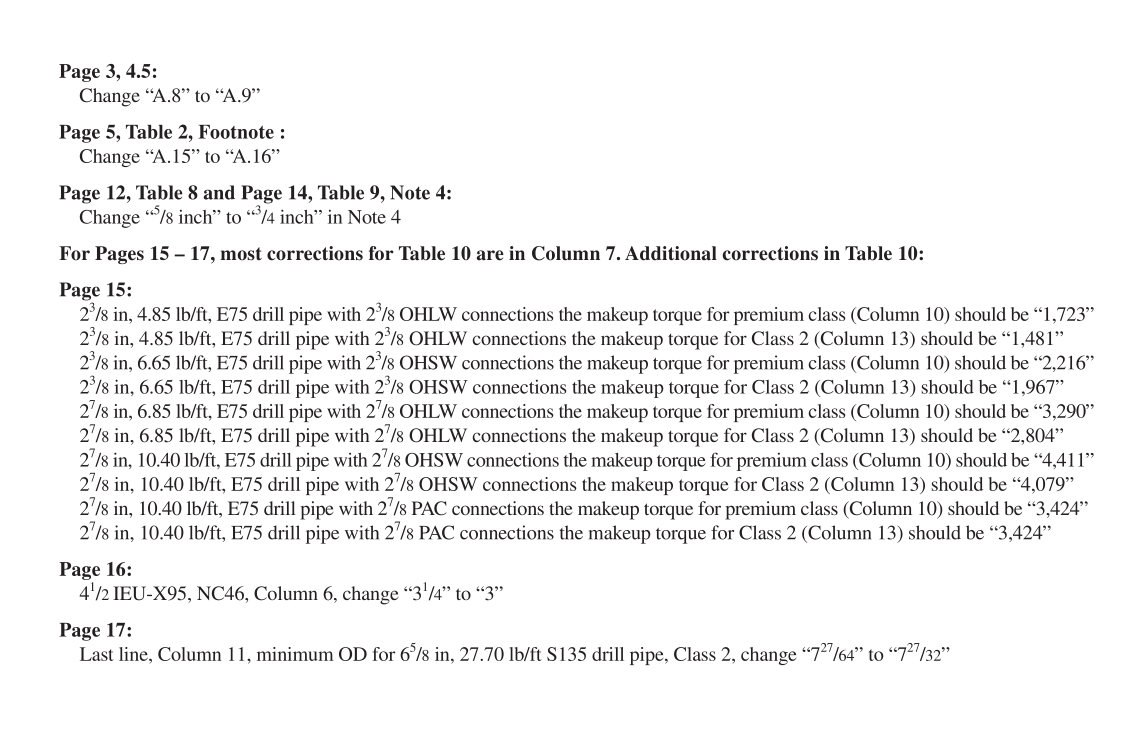API RP 7G pdf download

API RP 7G pdf download.Recommended Practice for Drill Stem Design and Operating Limits
14 Special Processes
14.1 DRILL STEM SPECIAL PROCESSES 14.1.1 Usually the materials used in the manufacture of down hole drilling equipment (tool joints, drill collars, stabilizers and subs) are AISI–4135, 4137, 4140, or 4145 steels. 14.1.2 These are alloy steels and are normally in the heat treated state, these materials are not weldable unless proper proce- dures are used to prevent cracking and to recondition the sections where welding has been performed. 14.1.3 It should be emphasized that areas welded can only be reconditioned and cannot be restored to their original state free of metallurgical change unless a complete heat treatment is performed after welding, which cannot be done in the field. 14.2 CONNECTION BREAK-IN Based on field experience, it has been observed that used rotary shouldered connections are less likely to gall than new connec- tions. It is believed that this is due to work hardening the connection surfaces. The process of Connection Break-In is a make-up and break-out of the connection under controlled conditions in order to provide surface work hardening prior to use. Connection Break-In may be done on the rig, as an optional manufacturing step, or at a service facility. Since many factors effect connection galling, Connection Break-In does not eliminate the possibility of galling. 14.2.1 Preparation for Connection Break-In Remove any storage or rust preventative coatings. Make sure that the connections are free of dirt or other debris. Thoroughly coat the threads and shoulders of both pin and box connections with a thread compound suitable for rotary shouldered connec- tions. Determine the recommended make-up torque of the connection. Make note of the friction factor of the thread compound and any adjustment required to the applied make up torque. See API Specification 7, Appendix G and API Recommended Practice 7A1 for further information on thread compounds and friction factor.
14.2.2 Connection Break-In at the Rig Taking care to align the connection, stab and make-up the connection slowly. Spinning in with a chain or high speed power spinner may cause galling. Using a calibrated torque gage or line pull indicator, slowly make-up to the recommended make-up torque. With manual tongs, use both sets of tongs and keep lines at 90 degrees for the final torque. Slowly break-out the connec- tion. During both make-up and break-out, watch for excessive resistance or other signs that could indicate the possibility of gall- ing. Wipe clean the pin and box connections and visually inspect for evidence of galling in the threads or sealing shoulders. If galling occurs, rework the connection prior to use. 14.2.3 Connection Break-In During Manufacturing When performing break-in at the factory or service facility, the connection should be finished machined, inspected, cold rolled (if specified) and preferably coated with an anti-gall material such as a phosphate or copper. Note: Break-in will change thread gage standoff. Slowly make-up three times to the recommended torque. Between each make-up, break-out only far enough to apply additional thread compound to the shoulders and last engaged threads. Break out the connection after final make-up. Wipe clean the pin and box and visually inspect for galling on the threads or shoulder. If galling occurs, the connection is rejected.At torque levels up to the make-up torque of the tool joint, the Make-up Torque THEN Tension curves are used to deter- mine the capacity. These curves are used when the maximum torque a connection will experience is the torque applied before tension is applied. The torque value used in this set of curves is the make-up torque or the applied torque, whichever is greater.









